#(not monarch caterpillars. these ones were black)
Explore tagged Tumblr posts
Text
Reading up on invasive plants continue to be a mistake because now that the garlic mustard's died back I am instead seeing dog-strangling vine everywhere. Admittedly Vincetoxicum rossicum and Vincetoxicum nigrum are pretty metal names but they really are out there blanketing the edge of every disturbed field and choking out the rest of the plant life...
#plant talk#t#i was interested in them for fibre reasons so at least i won't have to feel bad for harvesting them#this is a big reason why I'm trying to familiarize myself with invasive plants tbh#it's easy to confuse them with native milkweed at first but they're starting to flower now and the flowers are very distinct#i actually spent like 3 hours last night comparing their flowers to flowers of other milkweeds/dogbanes#because i was like there's SO many of them 😰#but... i guess that's what invasive plants do...#another way to tell them apart from native milkweeds is that the milkweeds are all being munched on by caterpillars#(not monarch caterpillars. these ones were black)#(there are other leptidora that are obligate herbivores on milkweed but i don't know what they are)#soooo. yikes.#these vines don't strangle dogs btw. no one knows why they're called that#i was gonna see if i could get anything workable out of garlic mustard but i waited too long#but Canada did release those weevils that only feed on garlic mustard so i don't think they're as big of an issue anymore#at least compared to these#which afaik don't really have any biological controls#if i harvest them I'll probably have to harvest in the evening right before the sun sets because i saw them growing among something that#looks suspiciously like ragweed. which is fine aside from the allergies. but ragweed also looks like wild carrot and wild parsnip#which are ABSOLUTELY NOT FINE and they will burn you like acid if you touch their sap and then go into the sun#no thank you !!#there's a few common plants that look like wild parsnip#but uhhhhhhh I'm not touching that lol#also found some wild grapes growing with them though! yum 😋#i don't care much for the grapes but the young shoots are sooooo good if you cook them up. they taste lemony
5 notes
·
View notes
Text
Butterfly Update
Well, of the three monarch caterpillars we took in before the frost, one of ‘em made it near the end of January. The other two may have been too young for squash to be enough, or carrying some kind of infection; lost one as a chrysalis, the other as a caterpillar.
But one did make it, developing quietly inside while outside got buried in snow and everything froze. By Sunday, though, it was moderately warm (for January) and sunny. Which is good, because that meant when he hatched out Sunday morning all we had to do was give him time to pump up his wings and then carefully pick him up and bring him out the door to a hedge for more sun.
(Yes, he. Male monarchs have black scent glands on the hind wings; if you’ve seen enough of them you can spot it.)
My roommate and I considered making some honey-water for a meal (another thing you can do for butterflies) but monarchs generally don’t eat the first day and the butterfly kept fluttering off the vinca flowers to rap against the window. Which risked wing damage. So we figured his chances were better if we just took him out and hoped for the best. Who knows what’s blooming out there, but even in winter on the Gulf Coast there’s usually something. Best we can do.
(We also considered taking him to a local nursery, but when we called they weren’t expecting flowering plants again until February.)
A fact you may not know about monarchs: there’s more than one migratory population of the species. Yes, there’s the major migration across the Gulf of Mexico. But there’s also a smaller population that migrates up and down the Florida peninsula every year, beating the frost that way. If our butterfly heads east, he might join that group.
For now we’re cleaning up, coddling the remaining milkweed cuttings so we can plant them in the spring, and hoping for the best.
Wish I had a pic of the butterfly for you, but once we got him outside - they’re fast!
I still wonder about the Victorians putting butterfly wings on fairies. It’s a striking image, but I haven’t found any folklore that connects butterflies to the fay. Though there’s no little amount that connects them to unquiet spirits and vampires!
...Butterfly-winged vampires. Urban fantasy writers, take it away!
8 notes
·
View notes
Note
every three generations there is a "supermonarch" that travels the whole distance from Mexico/southern U.S to Canada/Northern U.S (it takes normal butterflies three generations to migrate back to Mexico)
when the monarchs are almost ready to come out of the chrysalis its color turns to black with gold dots.
monarch caterpillars eat poisonous milkweed to deter predators from eating them. Milkweed is poisonous to humans (it won't kill you it'll probably just give you a rash and washing your hands will fix it)
monarchs "overwinter" in the south to escape the harsh winter. They usually rest on oaks, there are so many of them on one tree branches will bend and break.
monarchs have a very precise "inner clock" so they always arrive in the south on the same day or near the same day.
there were so many of them in the past that Mexicans believe that they carry the souls of the dead
I also have a monarch garden and it always gets overrun by aphids so
Fun Fact: one of the most effective ways for removing aphids is to spray them with a jet of water, it's fun ngl and it doesn't hurt the plants.
another option is taking them out one by one with rubbing alcohol, most preventative measures don't work very well so it's all just slaughtering the poor things 😭 you don't have to kill them because they don't hurt the caterpillars, but they DO hurt the plant so only kill them if they grow to cover the top stems
on sigma thanks for listening to me yap I'll probably make another one soon..😈
I ALSO LOVE YOUR ART just wanted to say
YAY MONARCH FACTS !!! im responding to all these so LONG POST EVERYBODY
supermonarch?? is it like just one monarch or like is that whole generation 'super'? also HUHHHHHHHH why does that even happen ? how does that even happen ?? thats so cool ????
their chrysalis turning gold-spotted black is so monarch coded i love that for them tbh

image of a branch of monarchs overwintering for everyone ^ :DDD,, actually crazy that they can bend/break branches by sheer numbers ?? i didnt know that ! really has me in awe thinking abt it
THE INNER CLOCK THING IS SO COOOL,, i wonder how climate change affects their clock? if at all,,, whether that be the current climate change or something like an ice age
now that's interesting,, abt Mexicans believing them to carry the souls of the dead ! ik butterflies have been related to souls/death in at least a few other cultures,, Japanese and Greek are springing to mind for me,,, its really interesting to see how that connection emerged in mexico though,, and it makes me wonder about other cultures too,,, btw are monarchs the only ones to do this great migration? or are their other species with something similar?
YAYY A MONARCH GARDEN but booo aphids 😔😔😔 shooting them with a hose sounds like a blast LOL omg i would i would
have you ever seen monarch's overwinter in person?? (i can only assume that they're very protected during this time, so if seeing them isn't even an option/bad for them or something forget i asked !!)
#TY FOR THE KNOWLEDGE !!! >;3333 on sigma on ligma on god o7777#and im glad you enjoy my art :DDDD !!!#looking forward to the next monarch class >:333#okramblings#ask
12 notes
·
View notes
Text
Creating a Backyard Land Spirit Profile
Working with land spirits can help connect you with your local ecosystem, and for some practitioners is a crucial aspect of bioregional magic. Some folks, like myself, consider themselves to be initiated by one or more land spirits.
When I use the term land spirits, I am referring to a few different things. First are the collective spirits of various plants, animals, and insects present in a specific bioregion. An example of collective, in this context, means that if I'm petitioning help from the spirit of violets, I am working with the spirit of all violets present in that area rather than a singe flower that grows in my yard.
The next is the land guardian, which in my practice is a more powerful spirit with claim over a specific territory, like a forest, river, or neighborhood.
Sometimes these two concepts are separate and sometimes they're interchangeable. It all depends on personal practice, culture, local folklore, etc.
One thing that has been extremely beneficial to my practice has been creating a backyard land spirit profile. This method has been useful for spirit work and "green" magic, but more importantly, it's helped me immerse myself in my local ecosystem and I get to meet a lot of cool animals and plants.
Here is an over-simplfied example of my backyard land profile:
Ecosystem: Central Interior and Appalachian: Mixed woodlands, close to possible floodplains
Soil Type: Clay in garden bed, Loamy near/beneath shrubs, Sandy in sunny areas of the lawn
Flora:
Cultivated- Paradise Apple, Highbush Blueberry, Rose of Sharon, Dog Rose, Black-Eyed Susan, Sundial Lupine
Native - Bloodroot, Wild Strawberry, Common Violet, Wrinkle-Leaf Goldenrod, Blue Wood-Aster, Horseweed, Fireweed, Deer-Tongue Witchgrass, Common Milkweed
Invasive - Round-Leaved Bittersweet, Yellow Toadflax, Creeping Bellflower, Common Mugwort
Naturalized - Dandelion, Broad-Leaf Plantain, Deadly Nightshade
Notes - Various mosses, unidentified mushrooms growing on lawn and lichens found on some trees/shrubs.
Fauna:
Mammals - Raccoon, Opossum, Striped Skunk, Grey Squirrel, Chipmunk, Feral Cats, Deer mouse, House Mouse
Birds - Cardinals, Chickadees, Catbirds, American Robin, Downy Woodpecker, Turkey Vulture, Crow
Reptiles and Amphibians - N/A
Fish - N/A
Invertebrates - Dotted Wolf Spider, Leopard Slug, Tiger Bee Fly, Monarch Caterpillars, Peach Root Weevile, Narrow-Winged Mantis, Fireflies
Ecoregion and Soil Type
The first thing I did was determine what type of ecosystem my yard used to be. In an urban/suburban area this was a bit challenging.
I started by identifying a few wild plants and finding out where they usually grow. Most of them seemed to prefer shady woodlands and rich soil. There were also a couple of pioneer species present in the sunnier and more disturbed areas of the yard.
Next, I took a look at surrounding wild areas. We are close to a mountain and a large river. There are woodlands near and within the city made up of mostly hardwood and conifer trees. I knew from memory that certain areas close to my home are likely floodlands.
After that, I found a bioregion map of my country which showed that my state fell under the category of Central Interior and Appalachian. I searched this region on landscope.org and was able to determine my specific ecoregion (not shared here for privacy reasons).
From there I started making educated guesses. I determined that my backyard was likely a mixed hardwood and conifer woodland sitting very close to what might have been a floodplain.
For my soil type, I took samples from different areas of my yard and used an online guide to determine what kind of soil I had. Most of it was sandy or loamy, but my flower beds seemed to have some clay.
Using all this information, I had a general idea of what kind of plants and wildlife would be present without human intervention. It also helped with deciding which native plants to start growing.
Plants
Throughout the year, I went out to the yard with a wildlife field guide and a couple identification apps and identified every plant and insect I found. I grouped the plants into four categories: native, invasive, naturalized, and cultivated. This isn't shown in the example, but I also grouped them by season and the time of year they appear.
Naturalized refers to plants that have integrated themselves into the environment without inflicting damage to the local ecosystem.
You'll notice that under the cultivated section I included a few native plants. This is because those plants were introduced by me and would not be present without my intervention and I wanted to make that distinction.
The importance of native and naturalized plants is obvious, but what about cultivated and invasive? Keeping a profile of invasive plants helped me keep a record of which noxious weeds I need to remove. From an ecological perspective, their removal is crucial to the survival of my native plants and garden crops. From a spiritual perspective, this can be an offering or act of service to the local land spirits. Some of these plants, like Common Mugwort, are both valuable for workings and fine to harvest in large quantities since they are invasive.
Cultivated plants are also important. Many of these plants, like my Blueberries, Apples, and Rose of Sharon, were here before me. The importance of plants introduced by humans is greater than you'd think. First, they are usually crops and flowering plants and provide food for both humans and the local wildlife. Secondly, I live in an urban area, and my land spirits are likely very closely associated with people.
I researched all of my plants and took note of growth patterns, toxicity, medicinal uses, ediblity, native region/habitat, ecological significance/impact, etc. Then I moved onto folklore and symbolism and started working with the spirits of a few plants, performing divination, leaving offerings, harvesting them and including them in rituals and spellwork. I did this in groups to avoid feeling overwhelmed.
Please note that you should always properly identify plants and be aware of potential toxicity before harvesting, especially if you plan on burning or consuming said plant. Also steer clear of protected or threatened plants and keep harvest to a minimum even for abundant native species.
Wildlife
My next project was writing down every species of animal and insect that I had encountered in my yard. I grouped them into several categories: mammals, birds, reptiles, amphibians, fish, and invertebrates. In real life my invertebrates section is separated into several subcategories (orb weavers, beetles, etc.).
Next, I used basically the same system I did for plants, researching their native range, preferred habitat, behavior, diet, ecological importance. Then I started looking into folklore.
Finally, I started integrating them into my practice and working with their collective spirits. This involved using animal symbolism in rituals, leaving offerings, and performing a lot of divination.
Remember to never interact with or directly feed wildlife. If I'm making offerings outdoors it is usually fresh water, scattered birdseed, and acts of service like creating habitats and growing plants that a specific species enjoys. If scattering birdseed, do so in the morning to keep too many animals, like raccoons, from entering your yard at night.
Side note: Keep a record of what appears in your yard each year! For example one year we had several chipmunks and one year I saw none. One year we had no fireflies and the next our backyard was covered in them.
Tying It All Together
Once I had my backyard profile completed, I started working with the collective spirits of select species. I have an offering schedule, perform communication, and petition these spirits regularly in spellwork. I use certain plants that I harvest for offerings and use for tinctures, infusions, cooking, and crafts. I use symbols of local animals in crafts and spellwork.
After working with the "smaller" spirits, you can start seeking out specific land guardians by using a combination of divination and research of local history and folklore.
On a mundane level, I am now able to cultivate an appropriate ecosystem for the local wildlife and start projects to support it. Examples of this are pollinator gardens, stick and brush piles for fireflies and small animals, growing seed-rich and fruiting plants for birds and mammals, winter shelters and TNR plans for feral cats, and more.
I also like to take notes on plants and wildlife that I encounter in my general area that don't usually make it into my backyard. For example there have been coyotes, foxes, bobcats, and black bears spotted in my neighborhood.
I want to stress that I live in a semi-urban and relatively populated neighborhood and I have a small yard. The brief example of of my land profile doesn't cover even a fraction of the wildlife I have encountered in my backyard. There is so much life in urban and suburban areas in need of our support.
#bioregional magic#spirit work#green witchcraft#land spirits#witchcraft#plant magic#local witchcraft
44 notes
·
View notes
Photo
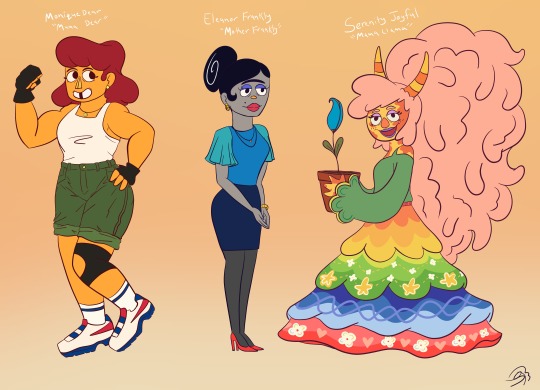

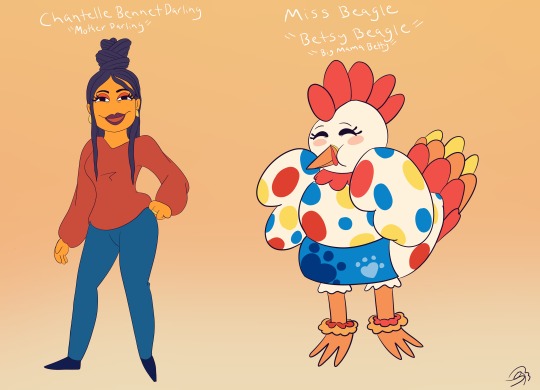
Okay for my Modern Welcome Au fanfic, I’m making a Mother’s Day chapter, and I decided to draw all the moms. Everyone except for Miss Beagle is my own thoughts how they would look.
Miss Beagle belongs to Clown aka PartyCoffin. I just fan drew her in a cute Barnaby’s paw print apron (You can see his pup print and the large one) and I decided to give her a first name for the fanfic, since she needs one and a cute mama nickname. “Big Mama Betty”
Anyway in order!
Monique Dear “Mama Dear”: Mother of Eddie Dear lives in Louisiana and is a post-man. Her husband die in a terrible truck accident before Eddie was born. She is a feisty, spunky woman that loves to go out doors, train for anything survival. She is a sweet mother and big tiger mom. When she sees her groan son, she would give him a bear hug and pick him up like he was a toddler. Very accepting and would sound like Carol from OK KO (VA: Kate Flannery) She’s always working out, since she have to lift heavy packages, and can cook!
Eleanor Frankly “Mother Frankly”: Mother of Frank. A calm, soft spoken woman. She is a Neurosurgeon, has the most steadiest hands. When she uses knives or scissors, she always cuts beautifully; one thing Eddie finds amazing because hello Crafting! She’s very intelligent, comes from a very wealthy family. Lives in New York, specifically Mid Manhattan with her husband. Yes, they are happily married, but once they saw Monique... 🤭 let’s just say they wanted to do a poly relationship.
Serenity Joyful “Mama Llama”: Mother of Julie. A funny nickname Jonesy came up when he was a toddler and stuck to the Joyful family. Don’t mind the colorful vomit skirt, rainbow monsters love to represent their family. Since, Serenity is all about Maximalism boho-chic outfits, she loves to represent her children’s colors. Believes in nature, spirituality, crystal healing, and listens to trees. Very laid back, sweet, and always goofy. Believes problems can be solved with yoga and Chamomile tea. Lives in the Rainbow Forest not far from the Welcome Home Residents.
Charlotte Partridge “Mama Lottie”: Mother of Poppy. She’s exactly like Poppy, but sweeter like honey! Very caring, hates cursing, and she knows how to cook. Her socks were made by Poppy, when she learned how to sew. Loves to support and protect all her children. She will treat everyone like her own kids. Lives in West Virginia!
Maria Gloria Pillar Garcia “La Jefe or Tu Jefe”: Mother of Howdy. In my fanfic, Howdy is Mexican American. As a joke, him and siblings like to call their mom, the boss or say, “Tu Jefe esta llamando” It’s a thing I noticed with Latino Americans say about their parents like the joke, “Your mom is calling you or My mom...” You don’t have to get it if you don’t. It’s a thing I’ve seen. Anyway, she’s the boss of the family, and knows how to run things. I mean this woman gave birth over 300 caterpillars, so she has the right to run her family and the family’s ranch. What I can say about her? She’s a Monarch butterfly, lives in Michoacán, Mexico. Used to live in East LA.
Chantelle Darling “Mother Darling: Mother of Wally. Lives in Atlanta, Georgia. She’s funny, nice, but cross the line with her and she’s the first to fight. Very protective of Wally, and his a widow. So her and Monique are gonna get along just fine.
Miss Beagle “Big Mama Betty”: Mother of Barnaby. That dog is a HUGE mama’s boy! Everyone in the neighborhood knows her, she’s sweetest Mother Hen.
I’ma say this too. If they were Humans, All of them except Maria and Monique would be African American/black! Monique would be biracial. Maria would be Mexican American with dark brown skin tone. My Au is about inclusivity for BIPOC/POC.
#welcome home#welcome home fanart#welcome home mothers#My Modern Welcome Home AU series#modern welcome home au#mothers#fanart#Wally Darling#Julie Joyful#Frank Frankly#Eddie Dear#poppy partridge#barnaby b beagle#howdy pillar#Wally's mom#Wally Darling's mom#Julie Joyful's mom#Frank Frankly's mom#Eddie Dear's mom#Poppy Partridge's mom#Barnaby b Beagle's mom#Howdy Pillar's mom#welcome home puppet show#all of their moms#everyone is mine except for miss beagle#my art#my girls#they would be bipoc#for my fanfic#my modern welcome home au series fanfic
60 notes
·
View notes
Text










Small Milkweed Bug - Lygaeus kalmii
Although this specie of crimson insect may appear similar at first glance to the Common Firebugs that were posted a short while ago, the patterning along its back clearly makes it something else. If you want to be absolutely sure, look for that black heart-shaped marking and the red 'X' pattern made by its wings. Despite its bright appearance, it has no fear to crawl out in the open, for this Bug's red coloration is an advertisement that isn't very tasty. In fact, its diet of milkweed associated material has lined its body with unpalatable substances. Specifically, the adults feed on the flower buds and pierce into milkweed seeds within the plant's spiky pods (and sometimes the flower nectar). While the adult Bug's rostrum can be unfolded from against its body for extended reach, the outer layer of seeds will probably be the first ones to be pierced. The nymphs will have better access to the number of seeds that they can directly feed on if they can find a way inside the pod. To be clear, the eggs are laid near the seed pod or on it, but not inside it; if the latter were possible, food for the nymphs would be much easier to come by.
Apparently one individual photographed here (Pictures 2, 6 and 9) may be trying its luck on the milkweed plant's young leaves and stem (it may be better off with the former). It may have the means to pierce the plant tissue and partial digest it before sipping, but it may not be able to handle a lot of the milkweed's viscous sap (depending on where and for how long it feeds). Unlike other milkweed-feeding insects such as Monarch Caterpillars or Red Beetles, the Small Milkweed Bug can't chew parts of milkweed to allow sap to bleed out, and its rostrum is a simple, thin appendage. It may be possible that this Bug relies on other insects to bleed the plants a bit before taking a sip of its own, but more observations would be needed. For the individuals here, they have a bounty of food and shelter thanks to this humble milkweed stalk approaching its bloom. In addition to all the ways milkweed serves this Seed Bug, it also makes for a suitable environment to find mates and meet other Bugs who were drawn to the plant. For the latter, the Small Milkweed Bug should be discerning about which insects it decides to scavenge on. The Red-Banded Leafhopper sharing the nearby leaf could make a good snack as - despite its bright coloration - it isn't a milkweed feeder, making it non-toxic.
Pictures were taken on June 26 and 27, 2021 with a Google Pixel 4.
#jonny’s insect catalogue#ontario insect#seed bug#small milkweed bug#true bug#hemiptera#heteroptera#insect#toronto#june2021#2021#red banded leafhopper#mating pair#nature#entomology#invertebrates#arthropods#photography#animals
4 notes
·
View notes
Text
so i recently got a job rearing butterflies and it goes without saying that i am not at all grossed out by bugs and im fine with touching them and dealing with frass and everything no problem
but
oh my god
(disgusting bug gore under the cut)
i DO NOT LIKE when they melt. its disgusting its horrible i hate it. i hate when they melt and i hate when pupae rot and break open and start oozing
disgusting disgusting disgusting and i have (usually lowkey sometimes very highkey) contamination OCD so im freaking out over these melted caterpillars my coworker training me said i could clean up the workspace when were done going through the bins but we dont know why they melt and i smeared some slime that used to be caterpillars where i was working so i had to pour peroxide over it all before i could resume working and still changed where i was working. horrible
if anyone has any idea why theyre melting please feel free to share. it seems sulphurs from one specific plant get it the worst, thats what i was dealing with today. but monarchs seem more susceptible to melting than some others but not nearly as much as the sulphurs
i also have always hated how uncertain the pupal stage is. as a kid my teacher raised butterflies sometimes and there were a lot of monarchs in my yard and i have many unpleasant chrysalis memories and now ill get to have even more
at least when i brushed against a pupa today and got wet with slime that was because it just eclosed and the butterfly was alive and flying and that was just residue from the miracle of metamorphosis. but then i was removing dead ones and multiple broke and black sludge came out. hate that. and they stink
honestly butterfly chrysalises are a little gross to me just because i dont like how they die. i feel similarly about turtles. like im so creeped out by them getting sick hurt or dying that i just get creeped out by them. it took me a bit to get comfortable holding the chrysalises because i was sure i was going to break them. i dont like when they wiggle because i wont want anything bad to happen
20 notes
·
View notes
Text




My Side Garden Over 4 Years
In 2019 the last of the 15 Ash Trees adjacent to my mother's home were taken out and I had decided to garden now that I had access to a yard again. The soil here is very rocky, prior to being constructed the side of this yard was a forest on the property line of a farm, that's why our ash were massive before they succumb to the borer.
The first year I planted some Perennials from a box-store and threw a random 'wildflower' seed mix in and unsurprisingly most of them died (although sweet-williams and cornflower persist which is fine with me)
The next year a whole bunch of annual cosmos and Zinnia took over but the only surviving perennials were native plants, after that I got more into native plants and got some native seeds from an adjacent field, Prairie Moon, and the forest that I spread. Then I got some native perennials from a local grower or took some divisions from my aunt (and grew some marigolds to keep the deer away).
The next year everything established and I did a layer of mulch over leaf litter to improve the soil a little, I discovered that in the coming drought this retained a decent amount of moisture for my young plants, I also noticed the diversity of insects and bird life that these plants brought. Our Yard was the only one with monarch caterpillars, constantly churning with butterflies, I noticed all new stingless bee species I'd never seen before, so many fascinating native fauna that never had decent habitat prior to this. I convinced the rest of my family to change their ways, less lawn, no pesticides at all, and less aggressive maintenance (I still weed but not as much because the perennials block out a lot of new growth). I noticed something else, fireflies I had grown up seeing were disappearing around the neighborhood, but not in this yard, because we had provided that proper leaf layer habitat for these fireflies, they were extremely abundant in our patch of garden. all the other neighbors who poison their gardens and heavily maintain lawns had nothing lighting up around them.
I'm studying in Landscape Architecture, work in architecture currently, my gardens look horrible because to me they are an opportunity to learn how plants grow. This year I made sure to keep leaf layer untouched in the hopes I could keep the fireflies, the garden looks really full even with little rain this may! it doesn't look perfect but the garden is more for ecosystem value (albeit rather small but to expand upon existing field nearby).
I try to plant things that I've seen growing wild locally, local natives in my garden as seen above include: Joe Pye Weed, Blueberry bush (highbush), Common Milkweed, Swamp Rose Milkweed, Butterfly Weed (ascelpias tuberosa), Columbines, White Snakeroot, spicebush, elderberry (this one is small in this garden), wild bergamot, various aster species, anise hyssop, and a tulip poplar sapling :)
Natives that are within this ecological region but not common to my area: blazing star, prairie blazing star, False Indigo, Blue flag Iris, Black eye'd Susan's, purple coneflower, obedient plant, Prairie dropseed, palm sedge, various sunflower species, bee balm, st. John's wort, whorled milkweed, various azaeleas, tickseed, eastern bluestar, Blue lobelia, and a persimmon tree
Nonnatives that do well and don't compete: English lavender, sweet Williams, 'Shasta' daisies, rocket larkspur, astilbes, cosmos (self seeding), tea rose, various herbs and annuals I throw in there like sunflowers, corn, amaranth.
17 notes
·
View notes
Text
The World and Lore of Hermit Heroes P.1
LOOOOOORRRRREEEE.
Sorry, had to get that out of my system for the Empires SMP peeps. Now, to note, I am mixing lore of several different TV shows and their worlds together so some things will be changed and messed with. I am a stickler for canon so this will be minimal but there is some stuff here and there that will be changed to fit the world.
I'll also add links to anything that might need further reading. Bits of lore that relate to a specific show will be color-coded to make it easy for anyone unfamiliar with the series to know what show it links to. In events where the majority of the text is lore-linked, only hyperlinks will be colored since otherwise it'd be a massive wall of text with one color and that's hard on the eyes after some time. Repeated mentions of the same thing will only be color-coded once, otherwise every mention of something like "Ephedia" would be colored and that might get annoying (it certainly did for me).
KEY: LoliRock Lore | Mysticons Lore | Miraculous Ladybug Lore | Winx Club Lore | Sailor Moon Lore
Parts of this Series
Part 1 (Empire of Ephedia, Creation of the Mysticons, Fall of Ephedia) - YOU ARE HERE
Part 2 (The Miracles & Creation of The Miraculouses, The First Sign of The Listeners) - Here
Part 3 (Empires SMP S1, Formation of Sirenix, The Sirenix Quest, The Solar Soldiers of Mezalea, Fall of the Empires) - Here
Part 4 (Fairies & Witches, Fairy Forms and Witch Forms) - Here
Part 5 (Current Time) - Here
Empire of Ephedia
So, let's start at the beginning with the Empire of Ephedia. This empire used to span the massive world of Empires SMP S1 from end to end. It was closed off, hiding away from the world. It was comprised of several smaller empires, the capital one being the kingdom of Gemima and it's capital of Drake City. Ephedia is where Crystal Magic was born, the magic type innate to every citizen born of Ephedia. Because of this, all Ephedians, young and old were capable of casting this magic and because it was so vital to their very existences, they would experience many side effects of the power such as longer lifespans upwards of 300 years, slower aging once grown and changes to appearance. Hair would change color while in the presence of Ephedian magic, becoming colorful and shiny with white magic.
While every citizen was able to use Crystal Magic, it was women who were strongest and most able to do so. This made Ephedia a strict queen-monarchy with a Queen reigning as the supreme ruler of Ephedia's empire whereas smaller empires had either a king or queen as their monarch. The King of Ephedia was instead a protector and ruled over the military and might of a kingdom, sworn to defend the kingdom. The women who wielded Crystal Magic would undergo a process known as "Shanila" when she was approximately 15 though younger cases around 12 have occurred (dubbed "early Shanilas"). Shanila is the stage at which a girl's power has grown enough that it can now progress even further, often likened to that of a caterpillar becoming a butterfly.
While Crystal Magic was often white magic, it also held a dark counterpart known as black magic. Black magic could not heal and would hurt both the caster and victim whenever used, so it was often used for evil purposes, necessitating a defense against its use. Since women were the most capable of magic, it was the princesses of every kingdom who were tasked to defend against black magic. Princesses were gifted items that allowed them to transform into an upgraded form, one that boosted their magic and powers and changed their outfit to one with a symbol on it, often one related to their kingdom or themselves. Most symbols were unique to the person but many times multiple princesses shared symbol types.
Creation of the Mysticons
Over time, Crystal Magic grew in strength, eventually attracting the attention of a race of powerful creatures, ones who could see, here, speak and do things with unknown limits to their power. They wanted the magic for themselves and attempted to destroy the empire of Ephedia to obtain it. Realizing that their very existence was in danger, the Ephedians created the Dragon Disc, forged in Gemima's Celestial Forge, an item that could imbue four chosen heroes with its own magic type and abilities, different from Ephedia's Crystal Magic.
These heroes were dubbed the "Mysticons" and were gifted lotus-shaped belt buckles to transform into the Dragon Mage, the Ranger, the Striker and the Knight. Their powers were each connected to an animal which could be called upon and summoned with a magic bracer colored to each animal and activated with a short phrase. A spellbook known as The Codex was also crafted, able to boost and increase the power of the Mysticons when used. The Mysticons were the most powerful force in the entire empire and would guard the many empires alongside the royal families of each one.
The Dragon Mage was the leader of the team, capable of calling upon the power of the Green Dragon. They wielded the Dragon Mage Staff and their special ability was called "Telekinesis". The Dragon Mage specialized in magic and sorcery, able to defeat enemies at any distance as well as commanding the element of fire.
The Ranger was the second-in-command, capable of calling upon the power of the Blue Wolf. They wielded the Ranger Bow and Arrows and their special ability was called "Super Speed". The Ranger specialized in expert marksmanship and ranged combat, defeating enemies from any distance without a sweat.
The Striker was the heart of the team, capable of calling upon the power of the Yellow Phoenix. They wielded the Striker Energy Hoops and their special ability was called "Pixie Blast". The Striker specialized in confusion and chaos, using explosions and whatever trickery they could to defeat enemies with pure madness.
The Knight was the tank of the team, capable of calling upon the power of the Pink Unicorn. They wielded the Knight Energy Sword and their special ability was called "Shield". The Knight specialized in melée combat, offensive and defensive moves, protecting the team and attacking with power, force and strength.
Fall of Ephedia & The Aftermath
Unfortunately, the combined powers could not prevent Ephedia's fall and the massive empire collapsed, taking every smaller empire inside of it with it. Drake City of Gemima took it the worst as the Mysticons were killed in the very heart of the city with the Dragon Disc and Codex shattering into 4 pieces and hidden by what remained of Ephedia's forces. The only remnant of Ephedia that remained to current knowledge is Crystal Magic which was passed down through stories and tales. After the destruction of its home, Crystal Magic was unstable and only able to be used by certain people. Meanwhile, the Mysticons remained dormant, pieces still scattered and for thousands of years, they were never called upon.
#HermitCraft#Hermitblr#Trafficblr#Empires SMP#Mysticons#LoliRock#Miraculous Ladybug#Winx Club#Hermit Heroes#Life Series
6 notes
·
View notes
Text
My Passion Project Part 2
.....Continued....
I remember the first hatch I ever saw at my co-op, which was also the first hatch my coworkers had ever seen. We’d been gathered around all morning because we knew it was going to hatch that day (the chrysalis goes from green to translucent once it is time). When it came out looking all shriveled, we all freaked out and a couple of us actually cried because we thought we had messed up the process for the poor thing. We were all hysterical wondering how it was going to fly with such crumpled wings. Luckily, some minutes later, the butterfly had developed into its more well-known state after pumping its wings.
I will never forget that experience and the fear that quickly turned to wonder.
After I’d moved on from the farm, all the eggs I find come from my own backyard. I average about 60 per summer, so over the years I have released just around 300 monarch butterflies. I have only lost 4 caterpillars total over all the years, so I feel accomplished. The losses are due to disease, I can’t be for certain which one (monarch caterpillars are victim to many), but I believe mine have been affected by O.E. (Ophryocystis elektroscirrha). This is a protozoan parasite that waits on the milkweed host plant to be ingested by the caterpillars. It is known as the “black death” because affected caterpillars often blacken and deflate just before dying. Below I have included a photo of a dead, diseased caterpillar, the only one I lost this past summer. Diseases like O.E. are a reason why it is so important to clean milkweed leaves before feeding the caterpillars, using a 10% bleach water solution. This is also why it is important not to overcrowd containers, so that sick caterpillars don't have the chance to spread the disease. Caterpillars may also be implanted with eggs by tachinid flies, so I make sure to always keep the enclosure door closed, stay vigilant when I am cleaning out containers, and take containers indoors to clean if they will be staying open for a while.
This past summer, I raised exactly 70, 38 males and 32 females. It is not too difficult to determine the sex, the easiest way being taking a look at the wings. Males have thinner veins and 2 glands which you can see circled in the photo I attached. Females have thicker veins and do not have the glands, as seen in another photo I attached.
I have also included a photo of me at Guelph Bug Day, which has a decent view of my enclosure and caterpillar containers.
If you wish to follow along/see more about my monarch adventures, feel free to follow my Instagram account which is dedicated to my monarchs @madelinesmonarchs 😊
In the off season, I post about other insects now and then!
Hope you enjoyed!
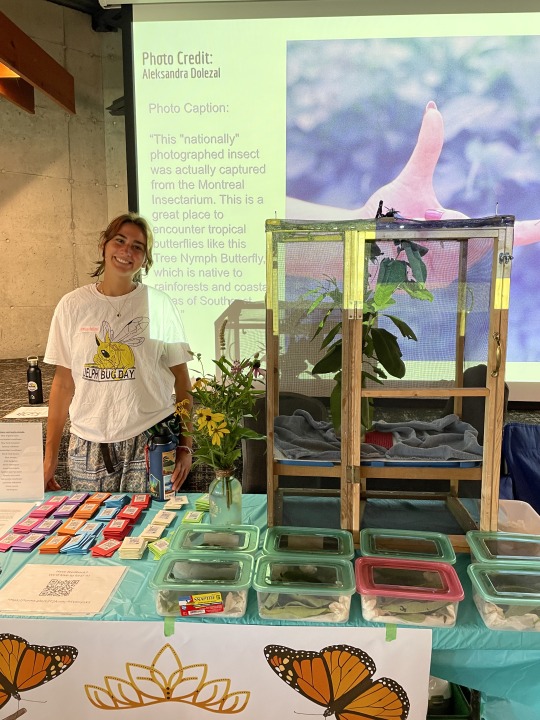







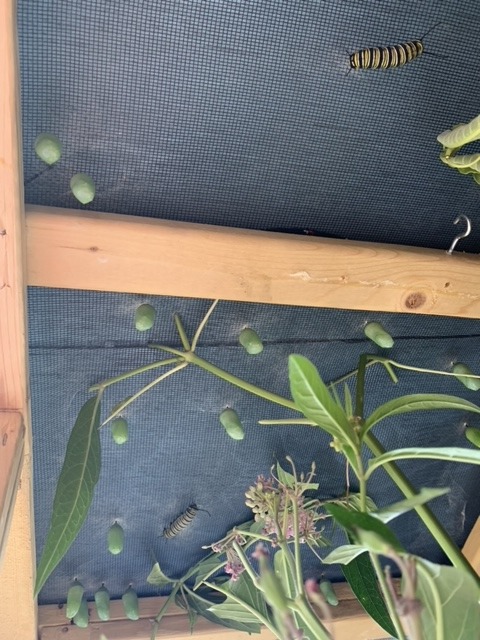
2 notes
·
View notes
Text
look up what butterflies are native to your area, find out what their host plants are, and start planting those. We have helped bring hundreds of gulf fritillaries and zebra long wings, along with monarchs when we were up in Pennsylvania, into the world, simply by planting their host plant.
Find out what milkweed is native to your area.
If you are in the eastern and southeastern United States especially, plant some purple passionflower (Passiflora incarnata). It is the host plant for 11 different species. And it has edible fruit that is delicious, and flowers that look like they're from an alien planet, and despite those alien looking flowers, it's native!
there's a whole bunch of tree species that are host plants as well. Tulip trees, oak trees, black walnuts, pecans, you don't even have to plant small things.
You can't solve climate change, but you can make a difference for hundreds and hundreds of butterflies with putting a single plant in your yard. Even if it's just in a container.
Just ask my mom, who despairs of ever seeing the passionflower we gave her actually flower, because it is constantly covered in caterpillars lol. (And our solution to this quote unquote problem? Planting more purple passionflower seedlings in the nearby woods so that the butterflies have more than one (1) single plant to go to in a 5 mi radius)
Seriously, and especially if you are up north in the northeastern US, plant common milkweed. Not only will it attract monarchs and provide a host for them, it is also the host plant for so many other awesome species. Like the absolutely adorable milkweed bugs and red milkweed beetles.
Again. You can't fix climate change, and it's not your fault. But if you literally just plant a single host plant, preferably more but if all you can do is one, trust me, trust my mom (who is so upset about this development lol), it will make a difference.
America's butterflies are disappearing because of insecticides, climate change and habitat loss, with the number of the winged beauties down 22% since 2000, a new study finds. The first countrywide systematic analysis of butterfly abundance found that the number of butterflies in the Lower 48 states has been falling on average 1.3% a year since the turn of the century, with 114 species showing significant declines and only nine increasing, according to a study in Thursday's journal Science.
Continue Reading.
284 notes
·
View notes
Text

The article includes an interactive. You keyboard your location, and you get a feedback of butterfly increase/decrease in that location. Excerpt from this New York Times story:
It’s hard to count insects.
Even as scientists have found that many populations are in decline, they’ve struggled to understand the scale of what’s happening. Now, a groundbreaking new study offers the most comprehensive answers to date about the status of butterflies in the contiguous United States.
In 20 years, the fleeting time it takes for a human baby to grow into a young adult, the country has lost 22 percent of its butterflies, researchers found.
“The loss that we’re seeing over such a short time is really alarming,” said Elise Zipkin, a quantitative ecologist at Michigan State University and one of the authors of the study, which was published on Thursday in the journal Science. “Unless we change things, we’re in for trouble.”
Little-understood and vastly underappreciated, insects play an outsize role in supporting life on earth. They pollinate plants. They break down dead matter, nourishing the soil. They feed birds and myriad other creatures in the food web.
“Nature collapses without them,” said David Wagner, an entomologist at the University of Connecticut.
Dr. Wagner, who was not involved with the new research, called it a “much-needed, herculean assessment.” He praised the study’s rigor and noted that the declines in butterflies, amounting to 1.3 percent per year, were in line with other recent efforts to analyze global trends in terrestrial insect populations.
Still, researchers didn’t have enough data to include some of the most imperiled butterfly species, which probably experienced some of the steepest declines. And the data was quite likely biased toward places where butterflies tend to show up. “Unfortunately for nature,” Dr. Wagner said, the findings are “undoubtedly a conservative assessment.”
The analysis was based on 12.6 million individual butterflies counted in almost 77,000 surveys across 35 monitoring programs from 2000 to 2020.
Of the 342 species for which they were able to draw conclusions, 33 percent showed statistically significant declines and less than 3 percent displayed statistically significant increases. Thirteen times as many species decreased as increased.
The American lady, an orange-and-black butterfly that ranges from coast to coast, was down 58 percent.
The Hermes copper, a rare butterfly found in San Diego County, plummeted by 99.9 percent.
Even the cabbage white, originally from Europe and so commonly found munching on vegetables as a caterpillar that it’s considered an invasive pest, dropped by half.
“That shocked me,” said Nick Haddad, an insect ecologist at Michigan State and an author on the study. “If even the cabbage white is declining, then, oh my God.”
The research could not shed much light on how monarch butterflies are doing, the authors said. Monarchs, which the U.S. Fish and Wildlife Service in December recommended for federal protection, have shown staggering declines in their overwintering sites in Mexico and California. But separate new data offered a dose of good news on that front: After hitting an almost record low last year, overwintering monarchs in Mexico rebounded significantly in this year’s count, made public by the Mexican government and the World Wildlife Fund on Thursday.
Scientists attributed much of the increase to an easing of drought conditions along the migration route of eastern monarchs, which travel between the United States, Canada and Mexico. But monarchs west of the Rocky Mountains, which overwinter in California, were at near record lows in this year’s count.
Why are butterflies crashing? Experts blame a combination of factors: habitat loss as land is converted for agriculture or development, climate change and pesticide use. What’s less clear is the extent to which each factor is driving the declines.
The study doesn’t try to answer that question, but it points to other findings, from the Midwest and California, that insecticides have played a particularly lethal role. A class called neonicotinoids, which Europe largely banned in 2018, was found to be especially deadly.
Members of the public are often called upon to plant native milkweed to help monarch caterpillars, but a study in the Central Valley of California found that every single collected sample was contaminated with pesticides. That was true even when landowners said they did not use pesticides, suggesting that the chemicals had drifted or had been applied to plants before purchase.
The new findings do show potential fingerprints from climate change. As the world warms, North American species are moving northward in search of more hospitable conditions. When researchers compared the same species in neighboring regions, they found that the northern populations were faring better than southern ones in three-quarters of cases. Moreover, two-thirds of the species that showed overall increases in the United States have ranges with more area in Mexico than in the United States and Canada, suggesting that perhaps they are growing in the northern parts of their range. Without data from Mexico, researchers can’t tell what’s happening there.
0 notes
Text

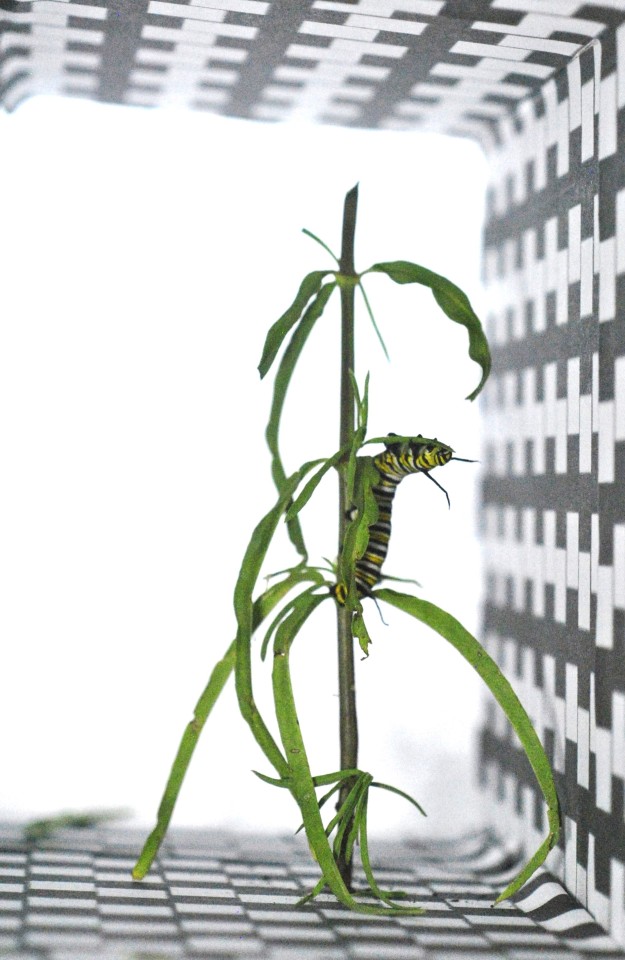






Incandescent Memory of the Caterpillar
Can you remember what you ate a week ago or have a recollection of every event you were involved in exactly? The life of a human is far more complex than a caterpillar can even imagine, however, the memory, visual recollection of moments, is believed possible for the monarch butterfly(Danaus plexippus) . Humans and animals are theorized to have access to multiple types of memory. Long-term memory which is important to the individual and stored for months or longer becomes beneficial to the longevity of a species. In a region where a nutritional abundance is located, the use of long-term memory is best used to remember the nutritional location. The alternative is called working memory, a type of short-term memory that is specific for solving problems or making decisions. I embarked on a journey to find out if this memory could withstand the chrysalis stage inferno.
The monarch butterfly goes through a complete metamorphosis that changes the entire physical appearance of the animal and its behavior. The fascinating monarch caterpillar completely changes their anatomy. Forming new legs and wings after spending 7-10 days in a chrysalis it survives a reaction that melts body parts. The heat is noted as an increasing form of energy that is described as an exothermic reaction, a reaction that releases energy in any form. The temperature increased from the initial date the chrysalis formed which was 65 Fahrenheit May 15 2024 to the date the chrysalis opened which was 70 degrees Fahrenheit May 30, 2024. A thermal energy camera was used to take pictures and get an accurate reading inside a chrysalis. The monarch spent 14 days in this hibernation chamber known as the chrysalis.
The experiment consisted of a monarch caterpillar that was put into what is described as a sensory box that has an illusionary black /white textile pattern around the entire box with an artificial light source on both ends. Observations were made to see if he recognized the milkweed plant (Asclepias syriaca) species moments after hatching. This will support the theory that the butterfly has memory from being a caterpillar. The butterfly was placed into the sensory box immediately after hatching after drying the wings and walking on the opposite side of where the plant was located the monarch butterfly pounced on the plant. The caterpillar recognized a natural milkweed plant that the caterpillar was previously devouring in the larvae state. No mouth for chewing exists and the newly hatched monarch butterfly has two long straw-like appendages to drink flower nectar. The caterpillar remembered the sensory input from the plant and stayed on top of the plant for the remainder of the experiment. After the experiment concluded I released the butterfly into the wild near some native milkweed plants.
My hypothesis was correct about the monarch butterfly having a memory from when it was a caterpillar. The complete metamorphosis in anatomy did not destroy the memory of the butterfly. Remembrance of working memory was used to decide to move towards the plant and attempt to eat it. Though this was done as a case study with only one caterpillar, the experiment achieved results that represent memory as a possibility of transformation for the rest of the species.
0 notes
Text
Every year we have the physical wherewithal, my family hunts Monarch caterpillar eggs to raise inside in safety. It's a good way to teach both science and nature to the kids.
They're so horribly endangered that every single butterfly we manage to release is a victory.
Under the cut is more of the story and images of our baby caterpillars. I just want to content warn on that because I'm sensitive to the fact some folks don't like bugs of any sort.
Last year we found only one. It was a rough June, disability wise, and very dry, so we didn't catch the first hatch. The only one we found was in August, so one of the methusela generation.
The methusela Monarchs are the ones who make the trip south every year. Not all of them do.
So far, this year, we've found 6 eggs that have definitely hatched into first instar caterpillars. (Monarchs have 5 instars, or stages, prior to butterflyhood.)
We were just out again and found 4 more eggs we think may be Monarchs. We're getting pretty good at identifying them, because we've been doing this for several years now. At least 8, if not more. Time is wibbly wobbly.
I just don't like to count my caterpillars before they hatch.
Part of why we're finding so many is our really healthy stand of milkweed. I had a few plants last year, but nothing like this year. More milkweed is obviously better.
This year's patch.

It's twice as big on the other side of the fence. 🤣
So, these are the first pics of the first hatches.
These were taken using a loooot of zoom on my phone. We look for first instars with a magnifying glass, they're so tiny.
The brown-black stuff is called frass. It's basically caterpillar poo. But it's one of the easier ways to find them when they're so teeny.


Here's an image of the eggs we found today. I've circled the maybe monarchs to make them easier to see.

Here's the first set of hatchlings again, two days later. Their growth process really doesn't take long. I've circled them, but it’s not really necessary to use a magnifying glass anymore.


We've interestingly (from a scientific perspective) lost one to cannibalism. We had 5, today we only had 4.
It's not unheard of in monarchs, I've just never had a cannibalistic one.
Here's our cannibal, and it's pretty obvious in the video what it's going for.
I can't figure out how to alt text a video on this platform, so I'll put it here. The following video shows a second or even third instar monarch caterpillar crawling very quickly toward a much smaller one.
So that one gets solitary confinement.


I'll update as things progress. We obviously give them fresh food whenever they need it. And they get misted with a very fine mist every time we change their food.
Given this is tumblr, I'll probably make a second post in a few days and link this one back. Second post is here.
As always, if you enjoy my content, please consider leaving a tip. I'm a disabled mom of two disabled kids and my work of words is my only income. We live far under the poverty line.
KoFi: http://ko-fi.com/A630KKM
Patreon: https://www.patreon.com/KaijaRayne
Paypal: https://www.paypal.me/KaelanRhy
Amazon Wishlist (general): http://www.amazon.ca/registry/wishlist/3H8AY0GKOU0SE/
Kids' wishlist: https://www.amazon.ca/hz/wishlist/ls/C3LS40BFVFPO/
#Monarch Caterpillar#citizen scientist#citizen science#monarch butterfly#Raising Monarchs#butterflies#caterpillars
0 notes
Text
April blog #1
Danaus Plexippus, The Monarch
April's butterfly of the month is danaus plexippus,the monarch. The scientific name for these monarchs "danaus plexippus" represents a sleepy transformation as they undergo the full butterfly cycle.These butterflies tend to migrate into North America from Southern Canada to Mexico.
The monarch butterflies which are a milkweed butterfly in the family Nymphalidae. Nymphalidae means a widely distributed family of butterflies mostly of medium or large size. They are one of the few caterpillars that eats members of the milkweed family. The milkweed plants contain a thick, foul-tasting milky liquid that flows into areas of the plant that have been damaged:eaten or broken. Monarchs use these plants as their source of nutrients. They get this liquid by chewing holes in the base of the main veins of leaves before they eat them to prevent excess milk from pouring into the leaf.
A compound they ingest from the milkweed makes them slightly poisonous to birds and other predators. They can use this as a great defense mechanism.
Monarchs use these milkweed plants to lay single eggs on the underside of the plants leaves. This species migrates to warm places because unlike other species monarchs cannot survive the cold winters of northern climates.
Monarch butterflies are a very social butterfly that are interested in people. They contribute to the health of our planet as they pollinate many types of wild flowers.
One of the most interesting things about monarch butterflies is that if one were to land on you it is a sign that you are on the right path and are heading in the right direction. This action can also be a sign of being careful and grateful for what you have in your life right now.

If you are interested in attracting the beautiful unique butterfly which possess two pairs of brilliant orange red wings featuring black veins and white spots along the edges it is recommended to plant lots of milkweed plants. In addition to the milkweed plants have a lot of colorful flowers. These flowers will attract monarchs and will be a source of nectar for them.
Let's honor these April butterflies of monarchs!
0 notes
Note
I went for a walk at a local urban wildlife refuge the other day, and they had a raised bed near the entrance of, according to the tag, swamp milkweed! No scientific name given though. There were a ton of buggies and eggs on them! What would you say they are? Are the eggs monarch caterpillars? I live in southeast Tennessee if the region helps you.

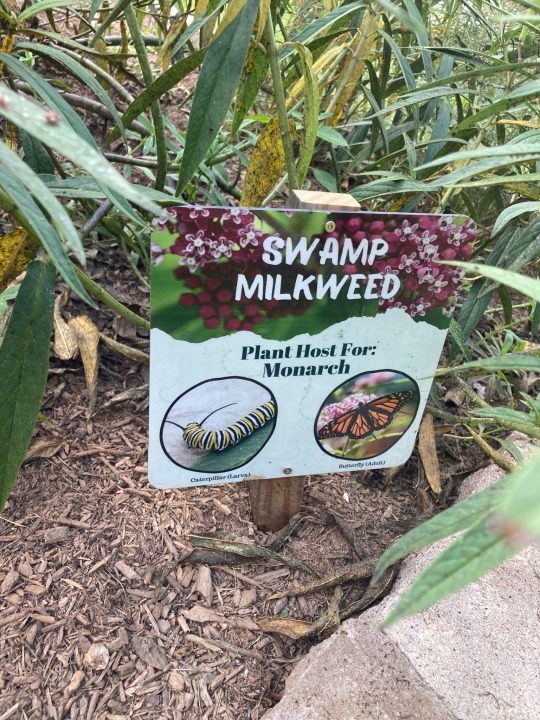
What look like little eggs are yellow aphids! They'll spend hours motionless just sucking on the plant's fluids!

People often panic when they see aphids and assume the plant is sick or dying, but it's natural for wild plants to be covered in them, and milkweeds are especially loved by all kinds of insects. You saw a very vibrant thriving community of organisms! The larger orange insects are the creatively named milkweed bugs. These are immature ones, since they get black and orange wings in their final molt:

Because milkweed is poisonous, milkweed bugs taste awful to predators and will make them sick, so there's another non-poisonous bug that closely mimics them.

Unfortunately this has the opposite of the desired effect in some places; especially in urbanized areas, milkweed and real milkweed bugs can be uncommon while the mimics are absolutely everywhere. Predators then slowly learn that MOST of the black and orange bugs they see are perfectly edible, so they take their chances, and then neither insect species is any safer than it was before. All of these insects (aphids, milkweed bugs, and the mimics) are genuine "bugs," too, the order Hemiptera!
179 notes
·
View notes